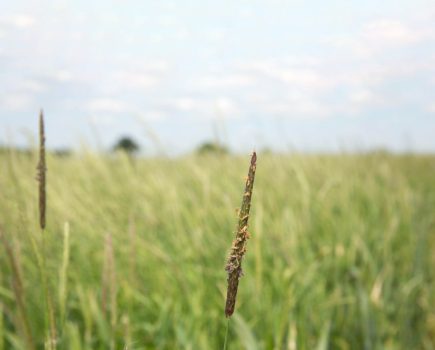Inability to travel plus cool, damp conditions last spring meant a distinct lack of T0s and therefore in many cases, yellow rust seized the opportunity to thrive. CPM looks at the importance of this spray timing in combatting the disease.
“We were chasing our tails on rust control, the disease was cycling so fast it was hard to keep on top of.” – PHOEBE FOSTER
By Janine Adamson and Rob Jones
Each season there’s a cereal crop disease of the moment depending on a range of external factors, namely weather conditions. Last year it was
rusts – both yellow and brown – which thrived in the cool wet spring following a mild winter.
With growers unable to travel and apply critical fungicide sprays, for those in high yellow risk regions, a lack of usual T0s meant the disease was able to repeatedly cycle and romp away. While for those on the fence, the consequences experienced by others may have proved a cautionary tale for the future.
According to Agrii agronomist, Phoebe Foster, it was evident which growers had succeeded with a T0 last spring and who hadn’t. “Subsequently we were chasing our tails on rust control, the disease was cycling so fast it was hard to keep on top of.
“I suspect growers and agronomists will be very wary as a result, and if they weren’t already considering a T0, be more open to it if the weather allows,” she says.
VARIETY RATINGS
Phoebe highlights that of the wheat varieties on the current Recommended List, there appears to be a significant quantity which are susceptible to rust. “With so many traits to consider, it’s easy to be caught out especially with brown rust, which had a terrible year last season.
“If you’re choosing a variety with lower rust scores, and/or are in a high pressure area, it’s best to mitigate early and go with a T0. It’s perceived as an additional spend but going for azole-based chemistry like Sakura (bromuconazole+ tebuconazole) is relatively cost-effective and means you can save the more expensive options for later in the fungicide programme,” she explains.
Sakura, marketed by Sumitomo, offers the power of two azoles in one product, highlights the firm’s Simon Leak. He adds that although the chemistry is older than newer actives on the market, when looking to devise a robust programme, Sakura is a solid option for T0 and combatting rust.
“There’s also a benefit in septoria control – admittedly tebuconazole won’t be the first port of call for this, but what Sakura does do is offer
a level of support for resistance management. That’s because there’s a case for using different azoles to target the different strains of septoria, which will also relieve some of the selection pressure on prothioconazole,” he says.
Despite this added bonus, Simon’s keen to stress that the main target of the product is yellow rust, a disease which is prevalent most years. “With Sakura you’re targeting this key disease at T0 but gaining an opportunity to add further diversity into the programme. This then reserves the ‘bigger’ chemistry for T1.”
He also recognises a threat looming on the horizon: “We have to be realistic that at some point, tebuconazole may disappear from the armory. For that reason, we’re in the process of registering straight bromuconazole as we believe that has a strong chance of retaining its regulatory status.”
If this does come to fruition, Phoebe points out that trial work has shown bromuconazole’s activity can equal that of prothioconazole when it comes to targeting eyespot, another tricky wheat disease. Whereas
Simon highlights that used together (bromuconazole plus prothioconazole), the duo could prove a cost-effective mix for T3, helping to control fusarium.
ON-FARM PERSPECTIVE
South Cambridgeshire grower, Sam Kiddy, is already on board with using azoles at T0. Given last year’s high yellow rust pressure situation, he’s taking a preventative approach across the 1200ha farm.
And despite scoring an 8 for yellow rust on the RL, it was a crop of Crusoe which was hardest hit, he says. “We’re growing the variety again this season but have halved the area to 200ha, plus we’ll be implementing a robust yellow rust programme with a mix of azoles,” he explains. Sam adds that this is the farm’s second year of using Sakura at T0, although septoria is usually the disease of primary concern. “We’ll target septoria from T1 onwards,” he comments.
PIPELINE SOLUTIONS
But with tebuconazole’s future looking uncertain, what impact might this have on fungicide programmes? Simon suggests a solution could be a new fungicide technology. “Sumitomo is in the process of securing registration for a new active ingredient technology known as Indiflin (inpyrfluxam), which will be targeted at the T1 and T2 timings. An SDHI, it’s already on the market globally, targeting diseases like soybean rust.
“If successful, it should also offer some activity on septoria, however, perhaps unsurprisingly, its main use will in combatting both rusts – yellow and brown – against which it’s achieved excellent control in UK trials, including the severe brown rust experienced last season,” he concludes.
This article was taken from the latest issue of CPM.
For more articles like this, subscribe here.
Sign up for Crop Production Magazine’s FREE e-newsletter here.




